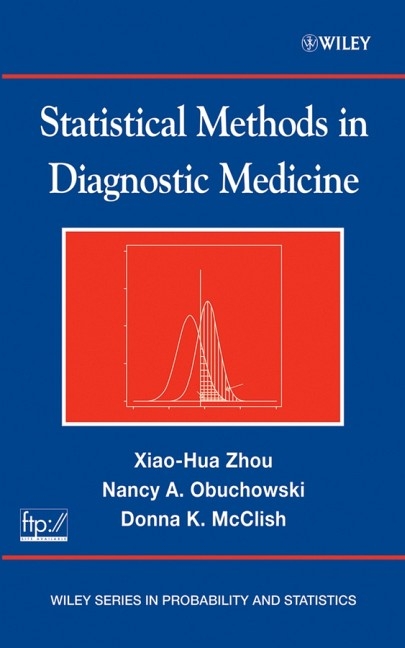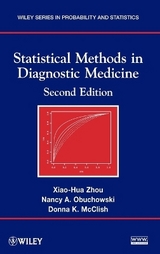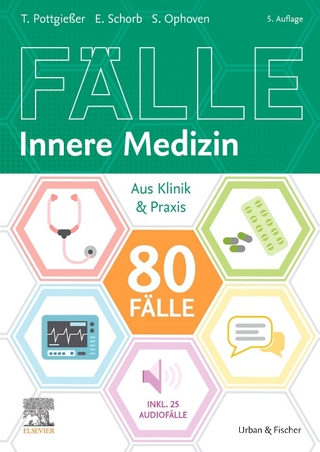
Statistical Methods in Diagnostic Medicine
John Wiley & Sons Inc (Verlag)
978-0-471-34772-9 (ISBN)
- Titel ist leider vergriffen;
keine Neuauflage - Artikel merken
An important role of diagnostic medicine research is to estimate and compare the accuracies of diagnostic tests. This book provides a comprehensive account of statistical methods for design and analysis of diagnostic studies, including sample size calculations, estimation of the accuracy of a diagnostic test, comparison of accuracies of competing diagnostic tests, and regression analysis of diagnostic accuracy data.
Discussing recently developed methods for correction of verification bias and imperfect reference bias, methods for analysis of clustered diagnostic accuracy data, and meta-analysis methods, Statistical Methods in Diagnostic Medicine explains: Common measures of diagnostic accuracy and designs for diagnostic accuracy studies Methods of estimation and hypothesis testing of the accuracy of diagnostic tests Meta-analysis Advanced analytic techniques-including methods for comparing correlated ROC curves in multi-reader studies, correcting verification bias, and correcting when an imperfect gold standard is used Thoroughly detailed with numerous applications and end-of-chapter problems as well as a related FTP site providing FORTRAN program listings, data sets, and instructional hints, Statistical Methods in Diagnostic Medicine is a valuable addition to the literature of the field, serving as a much-needed guide for both clinicians and advanced students.
XIAO HUA ZHOU is Professor in the Department of Biostatistics at the University of Washington and Director of the Biostatistics Unit in the HSR&D Center of Excellence at VA Puget Sound Health Care System. NANCY A. OBUCHOWSKI is Associate Staff at the Cleveland Clinic Foundation. DONNA K. McCLISH is Associate Professor of Biostatistics at Virginia Commonwealth University s Medical College of Virginia.
Preface. Acknowledgments. 1. Introduction. 1.1 Why This Book? 1.2 What Is Diagnostic Accuracy? 1.3 Landmarks in Statistical Methods for Diagnostic Medicine. 1.4 Software. 1.5 Topics not Covered in This Book. 1.6 Summary. I BASIC CONCEPTS AND METHODS. 2. Measures of Diagnostic Accuracy. 2.1 Sensitivity and Specificity. 2.2 The Combined Measures of Sensitivity and Specificity. 2.3 The ROC Curve. 2.4 The Area Under the ROC Curve. 2.5 The Sensitivity at a Fixed FPR. 2.6 The Partial Area Under the ROC Curve. 2.7 Likelihood Ratios. 2.8 Other ROC Curve Indices. 2.9 The Localization and Detection of Multiple Abnormalities. 2.10 Interpretation of Diagnostic Tests. 2.11 Optimal Decision Threshold on the ROC Curve. 2.12 Multiple Tests. 3. The Design of Diagnostic Accuracy Studies. 3.1 Determining the Objective of the Study. 3.2 Identifying the Target Patient Population. 3.3 Selecting a Sampling Plan for Patients. 3.3.1 Phase I: Exploratory Studies. 3.3.2 Phase II: Challenge Studies. 3.3.3 Phase III: Clinical Studies. 3.4 Selecting the Gold Standard. 3.5 Choosing a Measure of Accuracy. 3.6 Identifying the Target Reader Population. 3.7 Selecting a Sampling Plan for Readers. 3.8 Planning the Data Collection. 3.8.1 Format for the Test Results. 3.8.2 Data Collection for the Reader Studies. 3.8.3 Reader Training. 3.9 Planning the Data Analyses. 3.9.1 Statistical Hypotheses. 3.9.2 Reporting the Test Results. 3.10 Determining the Sample Size. 4. Estimation and Hypothesis Testing in a Single Sample. 4.1 Binary Scale Data. 4.1.1 Sensitivity and Specificity. 4.1.2 The Sensitivity and Specificity of Clustered Binary Data. 4.1.3 The Likelihood Ratio (LR). 4.1.4 The Odds Ratio. 4.2 Ordinal Scale Data. 4.2.1 The Empirical ROC Curve. 4.2.2 Fitting a Smooth Curve (Parametric Model). 4.2.3 Estimation of Sensitivity at a Particular FPR. 4.2.4 The Area and Partial Area Under the ROC Curve (Parametric Model). 4.2.5 The Area Under the Curve (Nonparametric Method). 4.2.6 Nonparametric Analysis of Clustered Data. 4.2.7 The Degenerate Data. 4.2.8 Choosing Between Parametric and Nonparametric Methods. 4.3 Continuous Scale Data. 4.3.1 The Empirical ROC Curve. 4.3.2 Fitting a Smooth ROC Curve (Parametric and Nonparametric Methods). 4.3.3 Area Under the ROC Curve (Parametric and Nonparametric). 4.3.4 Fixed FPR The Sensitivity and Decision Threshold. 4.3.5 Choosing the Optimal Operating Point. 4.3.6 Choosing Between Parametric and Nonparametric Techniques. 4.4 Hypothesis Testing About the ROC Area. 5. Comparing the Accuracy of Two Diagnostic Tests. 5.1 Binary Scale Data. 5.1.1 Sensitivity and Specificity. 5.1.2 Sensitivity and Specificity of Clustered Binary Data. 5.2 Ordinal and Continuous Scale Data. 5.2.1 Determining the Equality of Two ROC Curves. 5.2.2 Comparing ROC Curves at a Particular Point. 5.2.3 Determining the Range of FPR for Which TPR Differ. 5.2.4 A Comparison of the Area or Partial Area. 5.3 Tests of Equivalence. 6. Sample Size Calculation. 6.1 The Sample Size for Accuracy Studies of a Single Test. 6.1.1 Sensitivity and Specificity. 6.1.2 The Area Under the ROC Curve. 6.1.3 The Sensitivity at a Fixed FPR. 6.1.4 The Partial Area Under the ROC Curve. 6.2 The Sample Size for the Accuracy of Two Tests. 6.2.1 Sensitivity and Specificity. 6.2.2 The Area Under the ROC Curve. 6.2.3 The Sensitivity at a Fixed FPR. 6.2.4 The Partial Area Under the ROC Curve. 6.3 The Sample Size for Equivalent Studies of Two Tests. 6.4 The Sample Size for Determining a Suitable Cutoff Value. 7. Issues in Meta Analysis for Diagnostic Tests. 7.1 Objectives. 7.2 Retrieval of the Literature. 7.3 Inclusion Exclusion Criteria. 7.4 Extracting Information From the Literature. 7.5 Statistical Analysis. 7.6 Public Presentation. II ADVANCED METHODS. 8. Regression Analysis for Independent ROC Data. 8.1 Four Clinical Studies. 8.1.1 Surgical Lesion in a Carotid Vessel Example. 8.1.2 Pancreatic Cancer Exampl. 8.1.3 Adult Obesity Example. 8.1.4 Staging of Prostate Cancer Example. 8.2 Regression Models for Continuous Scale Tests. 8.2.1 Indirect Regression Models for Smooth ROC Curves. 8.2.2 Direct Regression Models for Smooth ROC Curves. 8.2.3 MRA Use for Surgical Lesion Detection in the Carotid Vessel. 8.2.4 Biomarkers for the Detection of Pancreatic Cancer. 8.2.5 Prediction of Adult Obesity by Using Childhood BMI Measurements. 8.3 Regression Models for Ordinal Scale Tests. 8.3.1 Indirect Regression Models for Latent Smooth ROC Curves. 8.3.2 Direct Regression Model for Latent Smooth ROC Curves. 8.3.3 Detection of Periprostatic Invasion With US. 9. Analysis of Correlated ROC Data. 9.1 Studies With Multiple Test Measurements of the Same Patient. 9.1.1 Indirect Regression Models for Ordinal Scale Tests. 9.1.2 Neonatal Examination Example. 9.1.3 Direct Regression Models for Continuous Scale Tests. 9.2 Studies With Multiple Readers and Tests. 9.2.1 A Mixed Effects ANOVA Model for Summary Measures of Diagnostic Accuracy. 9.2.2 Detection of TAD Example. 9.2.3 The Mixed Effects ANOVA Model for Jackknife Pseudovalues. 9.2.4 Neonatal Examination Example. 9.2.5 A Bootstrap Method. 9.3 Sample Size Calculation for Multireader Studies. 10. Methods for Correcting Verification Bias. 10.1 A Single Binary Scale Test. 10.1.1 Correction Methods With the MAR Assumption. 10.1.2 Correction Methods Without the MAR Assumption. 10.1.3 Hepatic Scintigraph Example. 10.2 Correlated Binary Scale Tests. 10.2.1 An ML Approach Without Covariates. 10.2.2 An ML Approach With Covariates. 10.2.3 Screening Tests for Dementia Disorder Example. 10.3 A Single Ordinal Scale Test. 10.3.1 An ML Approach Without Covariates. 10.3.2 Fever of Uncertain Origin Example. 10.3.3 An ML Approach With Covariates. 10.3.4 Screening Test for Dementia Disorder Example. 10.4 Correlated Ordinal Scale Tests. 10.4.1 The Weighted GEE Approach for Latent Smooth ROC Curves. 10.4.2 A Likelihood Based Approach for ROC Areas. 10.4.3 Use of CT and MRI for Staging Pancreatic Cancer Example. 11. Methods for Correcting Imperfect Standard Bias. 11.1 One Single Test in a Single Population. 11.1.1 Hypothetical and Strongyloides Infection Examples. 11.2 One Single Test in G Populations. 11.2.1 Tuberculosis Example. 11.3 Multiple Tests in One Single Population. 11.3.1 MLEs Under the CIA. 11.3.2 Assessment of Pleural Thickening Example. 11.3.3 ML Approaches Without the CIA. 11.3.4 Bioassays for HIV Example. 11.4 Multiple Binary Tests in G Populations. 11.4.1 ML Approaches Under the CIA. 11.4.2 ML Approaches Without the CIA. 12. Statistical Methods for Meta Analysis. 12.1 Sensitivity and Specificity Pairs. 12.1.1 One Common SROC Curve. 12.1.2 Study Specific SROC Curve. 12.1.3 Evaluation of Duplex Ultrasonography, With and Without Color Guidance. 12.2 ROC Curve Areas. 12.2.1 Fixed Effects Models. 12.2.2 Random Effects Models. 12.2.3 Evaluation of the Dexamethasone Suppression.Test. Index.
| Erscheint lt. Verlag | 31.7.2002 |
|---|---|
| Reihe/Serie | Wiley Series in Probability and Statistics |
| Zusatzinfo | Ill. |
| Verlagsort | New York |
| Sprache | englisch |
| Maße | 164 x 245 mm |
| Gewicht | 755 g |
| Einbandart | gebunden |
| Themenwelt | Mathematik / Informatik ► Mathematik ► Statistik |
| Mathematik / Informatik ► Mathematik ► Wahrscheinlichkeit / Kombinatorik | |
| Studium ► 2. Studienabschnitt (Klinik) ► Anamnese / Körperliche Untersuchung | |
| Studium ► Querschnittsbereiche ► Epidemiologie / Med. Biometrie | |
| ISBN-10 | 0-471-34772-8 / 0471347728 |
| ISBN-13 | 978-0-471-34772-9 / 9780471347729 |
| Zustand | Neuware |
| Informationen gemäß Produktsicherheitsverordnung (GPSR) | |
| Haben Sie eine Frage zum Produkt? |
aus dem Bereich



